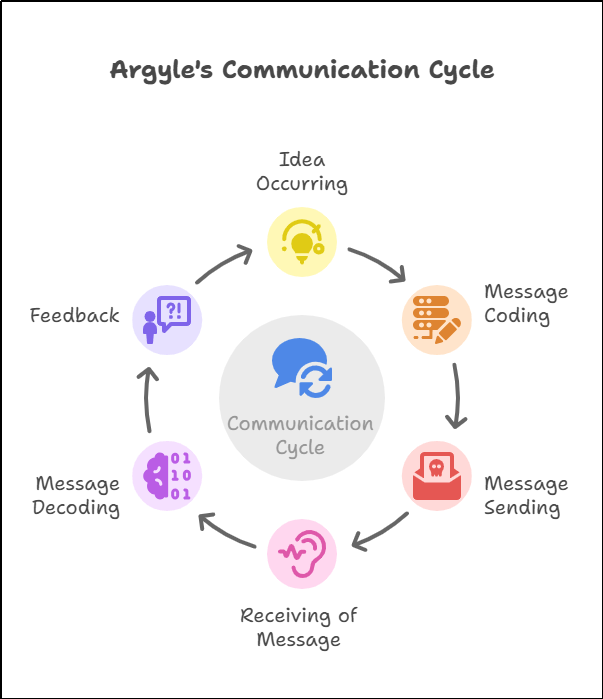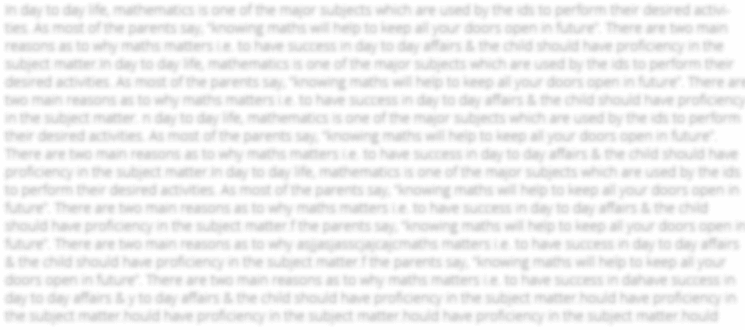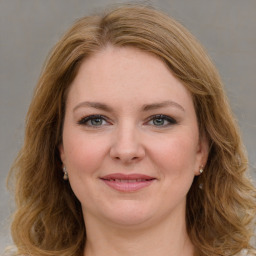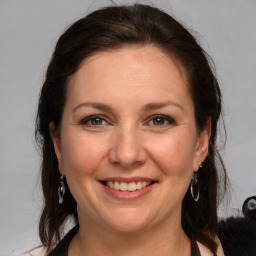The Communication Cycle by Argyle is a theory that explains communication as an interactive, continuous process that has six significant points or phases, which are the occurrence of the idea, the coding of the message, the sending of the message, the reception of the message, the decoding of the message, and the feedback (Dimbleby and Burton, 2020). Whereas linear models assume a one-way form of communication, the Argyle model emphasises a cyclical form, where feedback mechanisms make communication a two-way process. This cycle considers both verbal (spoken or written words) and non-verbal (body language, facial expressions and gestures) communication since they interact to create meaning. The model has been found very useful in situations where the use of effective interpersonal skills is needed, like in healthcare, education and workplace relationships.
Stages of the Communication Cycle
-
Message Sending:
The coded message is then carried to a selected channel, a couple of examples being speech and writing, or gestures. At this step, one has to think about the context and channel of communication. As an illustration, the physician talks clearly, makes eye contact, and applies gestures when stressing an important point during the appointment. -
Message Coding:
After the idea has been conceived, the communicator codes this message into a communication message. This entails selection of the right words, tone and non-verbal signals to indicate the intended message (Grillo and Enesi, 2022). As an example, the practitioner may choose to use basic, non-technical terms to make sure that the patient has grasped the diagnosis, but in a soothing and sympathetic voice. -
Idea Occurring:
This is where a person gets an idea or a desire to communicate, and the cycle starts. This step refers to the creation of an idea or a goal, which could be to inform, communicate an emotion, or convince someone. In another instance, a physician might choose to interpret a diagnosis to a patient. It is important that the idea be clear at this phase because vagueness of intent may cause miscommunication. -
Receiving the Message:
The recipient receives the message using his senses, especially hearing and sight. This phase is reliant on the receiver of the message and how keen they are in reading the message. The patient might not be fully receiving the message in case he or she is distracted or experiencing hearing problems. -
Message Decoding:
The recipient receives and decodes the message to get the meaning. It includes the processing of verbal and non-verbal information. By way of illustration, the patient listens to the words of the doctor, along with his or her compassionate intonation, to understand the diagnosis and what it entails. A wrong perception may arise when assumptions or feelings of the recipient come in the way. -
Feedback:
Feedback is given by the recipient of the message, and this indicates whether the message has been received in the right way (Lipnevich and Smith, 2022). The feedback may be verbal (i.e. by posing a question) or non-verbal (i.e. by nodding). This step closes the loop and can start a new loop when the initial sender reacts to the feedback. In the doctor-patient case, the patient can raise a question for clarification, and the doctor may talk more.

Applications of the Communication Cycle
Communication Cycle, which was developed by Argyle, finds a lot of application in areas where interpersonal communication is essential (Hargie, 2021). In medical practice, the model is applied to maintain effective communication between professionals and patients, decreasing misconceptions regarding the diagnosis or treatment. Indicatively, when talking to a patient, nurses will use a non-verbal cue, such as a facial expression, to understand his or her emotional status to tailor their communication. Educators use the cycle to communicate with the students and gain feedback to check their understanding and revise their instruction. The model is applicable in business, where it aids managers to provide their staff with concise directions and understand worker feedback, which encourages teamwork and efficiency. The focus on feedback in the cycle makes it especially useful in conflict resolution, where repetition in communication can be used to resolve misunderstandings. Also, check out assignment writing help for your assignment concerns.
-
Model Strengths
The Communication Cycle has a couple of strengths. First is its cyclical character, which is responsive to the dynamic reality of communication that messages are not sent in a vacuum but as part of an ongoing, burgeoning exchange. Second, the consideration of non-verbal communication follows the studies of social psychology by Argyle, in which it is important to consider the role of body language when deriving meaning. Research indicates that up to seven-tenths of communication is non-verbal, hence such an emphasis is quite timely. Third, the model is very simple, which means that it can be used in practice in a variety of contexts, including not only informal communication but also business. Last but not least is the feedback focus, which makes the communication adaptive, where the communicators can change their strategy according to the reaction of the recipient (Maibach et al., 2023).
-
Model Limitations
Communication Cycle by Argyle has weaknesses in spite of its strong aspects. First, it presupposes equal involvement and the ability of the parties to communicate successfully, which might not be applicable in situations of language differences, mental disorders, or emotional shock (SWARGIARY, 2025). As an illustration, an anxious patient might fail to accurately decode a message from a doctor. Second, the model does not consider explicitly external issues that may interfere with the communication, like noise or cultural differences. Third, it is centred on in-person communication and cannot be easily applied to the digital or written one, where non-verbal communication is barely present. Lastly, the model can simplify the complex interactions, which include group communication, where several cycles can occur at the same time.
Get free assignment examples!
Conclusion
The Communication Cycle presented by Argyle is still a useful model in interpreting interpersonal communication and enhancing it. It also gives a clear guide on how to achieve successful interaction by dividing the process into six stages: idea occurrence, message coding, sending, receiving, decoding, and feedback. Its focus on non-communication and feedback coincides with the intricacies of human interaction, which makes it applicable to various situations, including healthcare, education and business. It has drawbacks, as it could be biased to face-to-face communication and does not consider external barriers, but it is simple and adaptable, which will keep it relevant.
References
- Dimbleby, R., and Burton, G. (2020). More than words: An introduction to communication. Routledge.
- Grillo, H. M., and Enesi, M. (2022). The impact, importance, types, and use of non-verbal communication in social relations. Linguistics and Culture Review, 291-307.
- Hargie, O. (2021). Skilled interpersonal communication: Research, theory and practice. Routledge.
- Lipnevich, A. A., and Smith, J. K. (2022). Student-feedback interaction model: Revised. Studies in Educational Evaluation, 75, 101208.
- Maibach, E. W., Uppalapati, S. S., Orr, M., and Thaker, J. (2023). Harnessing the power of communication and behaviour science to enhance society's response to climate change. Annual Review of Earth and Planetary Sciences, 51(1), 53-77.\
- SWARGIARY, K. (2025). Communication Skills (Skill Enhancement Course) Paper Code: EDNSEC-101-3. ERA, US.




















